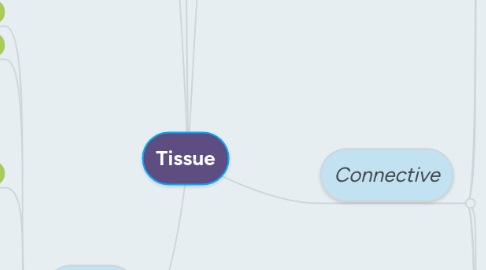
1. Membranes (Epithelial+Connective)
1.1. Mucous Membrane (Muscosae)
1.1.1. Lines passageways for the outsides,
1.2. Serous
1.2.1. Membrane is thin but strong
1.2.2. lines inside cavities, not the outside
1.3. Cutaneous
1.3.1. thick waterproof and dry
1.3.2. Its the skin!
1.3.3. consist of stratified squamous epithelium, areolar tissue and dense irregular connective tissue
1.4. Synovial
1.4.1. Line moving (Articulating) joint cavities
1.4.2. produce synovial fluid to lubricate joints
1.4.3. protects the ends of bones and allow free movement
2. Nervous (Neural)
2.1. Neuron
2.1.1. Cell body (Soma)
2.1.2. Dendrites
2.1.3. Axon
2.1.4. send impulses
2.2. Neuroglia
2.2.1. holds neurons together and supports them by supplying them nutrients.
2.3. Inflammation
2.3.1. coordinated response to damage or invasion of tissue
2.3.2. common traits: swelling, warmth, red, pain
2.4. Inflammatory Response
2.4.1. Necrosis
2.4.2. Pus
2.4.2.1. accumulates in the wound - dead tissue and cellular debris
2.4.3. Abscess
2.4.3.1. pus trapped in a closed area
2.4.4. Histamine
2.4.5. Heparin
2.4.6. Prostaglandins
2.4.7. Dilation
2.4.7.1. widening of blood vessels increases blood circulation in the area causes warmth and redness
2.5. Conducts electrical impulses from one region of the body to another
2.6. 98% is just in the brain and spine
2.7. Longest cells in the body! Up to 1 meter
2.8. most cannot divide or repair themself
3. Muscle
3.1. Actin
3.2. Myosin
3.3. Skeletal Muscle Tissue
3.3.1. Muscle Fibers
3.3.2. Satellite cells
3.3.3. mobilizes skeleton
3.3.4. forms the large body muscles responsible for major body movement like walking
3.3.5. do not divide. New fibers are produced by stem cells called satellite cells.
3.3.6. Striated, voluntary, and multi nucleated
3.4. Cardiac Muscle Tissue
3.4.1. Intercalated disks
3.4.1.1. the formed branching network
3.4.2. circulates blood
3.4.3. found only in the heart. cells are called cardiocytes
3.4.4. have a single nucleus and its involuntary.
3.5. Smooth Muscle Tissue
3.5.1. lines passageways moves food and secretions
3.5.2. found within the walls of hollow organs that contract. Urinary bladder, digestive, reproductive and blood vessels.
3.6. for contraction
3.7. interacts between filaments of actin and myosin
4. Epithelial
4.1. Simple Squamous
4.1.1. Diffusion and filteration
4.2. Simple Columnar
4.2.1. Goblet Cells
4.2.2. Secretion and absorption in digestive and uterus.
4.2.3. Makes mucus
4.3. Simple Stratified
4.4. Simple Cuboidal
4.4.1. Secretion and absorption
4.5. Stratified Squamous
4.5.1. Protection in skin and mouth
4.5.1.1. We have 30 layers of cells for our skin
4.6. Pseudostraified Columnar
4.6.1. Lines air passages and can have goblet cells (Mucus secreting cells) and cilia.
4.7. Transitional Epithelium
4.7.1. Stretchable, blocks diffusion. Found in the urinary bladder.
4.8. Covers All Body surfaces both inside and out.
4.9. Has no blood supply
4.10. Fastest growing tissue
5. Connective
5.1. General Types (Ground Substance)
5.1.1. Connective Tissue Proper
5.1.1.1. Cells and fibers within a matrix containing syrupy ground substance. Like fatty tissue under your skin.
5.1.2. Fluid Connective Tissue
5.1.2.1. Cells suspended in watery ground substance, blood.
5.1.3. Supporting (Dense) Connective Tissue
5.1.3.1. Cells suspended in dense ground substance. Cartilage and bone.
5.2. Cells
5.2.1. Fibroblasts
5.2.2. Macrophages
5.2.3. Adipocytes
5.2.4. Mast Cells
5.3. Fibers
5.3.1. Collagenous Fibers
5.3.2. Elastic Fibers
5.3.3. Reticular Fibers
5.4. Categories
5.4.1. Loose (Areolar)
5.4.1.1. Binds underlying organs to skin and to each other.
5.4.1.2. Forms delicate membrane through body
5.4.2. Adipose
5.4.2.1. Adipocytes
5.4.2.2. AKA fat
5.4.2.3. Beneath the skin around kidneys and eyes.
5.4.2.4. Protects and cushions and preserves body heat. And stores energy
5.4.3. Fibrous
5.4.3.1. Tendons
5.4.3.1.1. Muscles to bones
5.4.3.2. Ligaments
5.4.3.2.1. bones to bones
5.4.3.3. Dense tissue closely packed and fine network of fibers
5.4.3.4. Few cells, low blood supply, so slow healing.
5.4.4. Cartilage
5.4.4.1. Chondocytes
5.4.4.2. Hyaline Cartilage
5.4.4.2.1. Fine white (collagenous) fibers. spine disks. Most common cartilage. at the end of bones and joints.
5.4.4.3. Elastic Cartilage
5.4.4.3.1. Flexible and elastic external ear and larynx
5.4.4.4. Fibrocartilage
5.4.4.4.1. Very tough, menisci. Numerous collagenous fibers.
5.4.5. Blood
5.4.5.1. Formed Elements
5.4.5.1.1. RBC's
5.4.5.1.2. WBC's
5.4.5.1.3. Platelets
5.4.5.2. Plasma
5.4.6. Bone (Osseus)
5.4.6.1. Osterocytes
5.4.6.2. Rigid due to mineral salts
5.4.6.3. Long cytoplasm extensions that form canals
